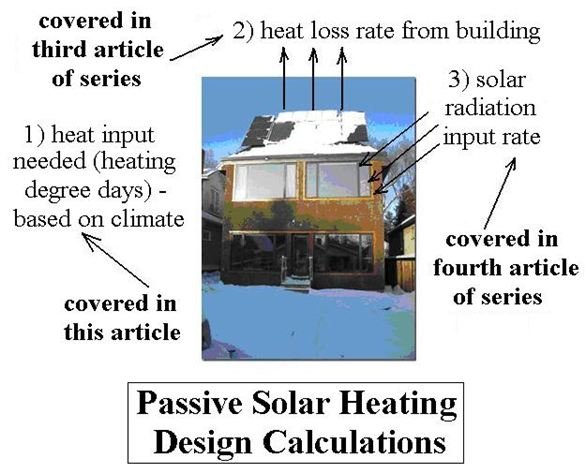Data on Heating Degree Days for Estimating Passive Solar Heating Requirements
Degree Days Definition
Degree day data provides information on the heating or cooling needs for buildings at a specified location. The value of degree days for a given day is the difference between the average temperature for that day and a specified base temperature. The average temperature for the day is calculated as the average between the maximum and minimum temperature for the day. The commonly used base temperature is 65oF (18.3oC). When the average temperature for the day is less than the base temperature, implying a need for heating, then the value is called ‘heating degree days’. When the average temperature is greater than the base temperature, implying the need for cooling, then the value is called ‘cooling degree days’. We will be interested in heating degree days for passive solar heating system calculations.
A Source for Heating Degree Day Data
Heating degree day data is available from a variety of sources. A convenient source is the _Solar Radiation Data Manual for Buildings,_published by the National Renewable Energy Laboratory (NREL). It is available for free download at https://rredc.nrel.gov/solar/pubs/bluebook/. This publication has data on heating degree days for 239 locations in the United States and its territories. Monthly average and yearly average values for heating degree days are given for each of the 239 locations based on data collected from 1961-1990 for those 239 sites.
The manual contains quite a bit of other useful data also, but this article will be zeroing in on the data for heating degree days. The manual has a page for each of the 239 locations and the pages are arranged alphabetically by two letter postal abbreviation for the states and territories and alphabetically by city within the states and territories. So, the first page of data is for Anchorage, Alaska (AK), and the last (239th) page of data is for Sheridan, Wyoming (WY).
Data on Heating Degree days for Selected Locations
In order to get a feeling for the meaning of heating degree day values, data for selected locations has been extracted from the NREL data manual in the table below.
……………………………….Heating Degree Days, base 65o (oF-days)…………………………………
Location……….Anchorage, AK………..Boulder, CO…………Albuquerque, NM…………Phoenix, AZ
January ………….1553………………………1094……………………….955……………………………362
February…………1296……………………….885………………………..700……………………………227
March…………….1218……………………….806………………………..561……………………………182
April……………….876………………………..504………………………..301……………………………..75
May……………….570………………………..253…………………………89……………………………….8
June………………318………………………..71…………………………..0…………………………………0
July……………….205…………………………0……………………………0…………………………………0
August……………270…………………………0……………………………0………………………………..0
September………498……………………….144…………………………18…………………………………0
October………….942……………………….429…………………………259………………………………17
November……..1314……………………….780…………………………621……………………………..134
December…….1510………………………1054………………………..921………………………………345
Annual………10,570………………………6020……………………….4425…………………………….1350
Interpretation of Heating Degree Day Data
The heating degree day data in the table above should make sense to you if you are familiar with the locations of the cities in the table. Anchorage, AK is the farthest north (61.17oN latitude) and has the greatest heating requirement as would be expected. The latitudes for the other cities in the table are: Boulder, CO - 40.04oN; Albuquerque, NM - 35.05oN; and Phoenix, AZ - 33.42oN. Other climate factors like elevation and presence or absence of cloud cover are important too. The latitude and elevation of each of the 239 cities are given in the NREL data manual.
The figure above shows how the information about heating degree days in this article fits into the series of articles about ‘Passive Solar Design Calculations. (Click on the picture to see a larger version.) The next two articles in the series will cover estimation of heat loss rate from a building and obtaining data about the rate of solar radiation input available at a location of interest. The last article of the series will go over a procedure for putting all of this together to estimate the percentage of heating requirements that a given passive solar heating system will provide.
This post is part of the series: Passive Solar Design Calculations
Passive solar heating systems use components of a building, building orientation, and building design to provide passive solar heat. Calculations involving heating degree days, building heat loss rate and solar insolation data can predict the performance of a passive solar heating system.
- Principles of Passive Solar Heating Systems and How They Work
- Heating Degree Days for Passive Solar Heating Systems in the U.S.
- Estimation of Heat Loss/Heating Needs from Your Utility Bills
- Solar Insolation Data for Passive Solar Heating at Your Location in the U.S.
- Estimating Passive Solar Heating System Performance
